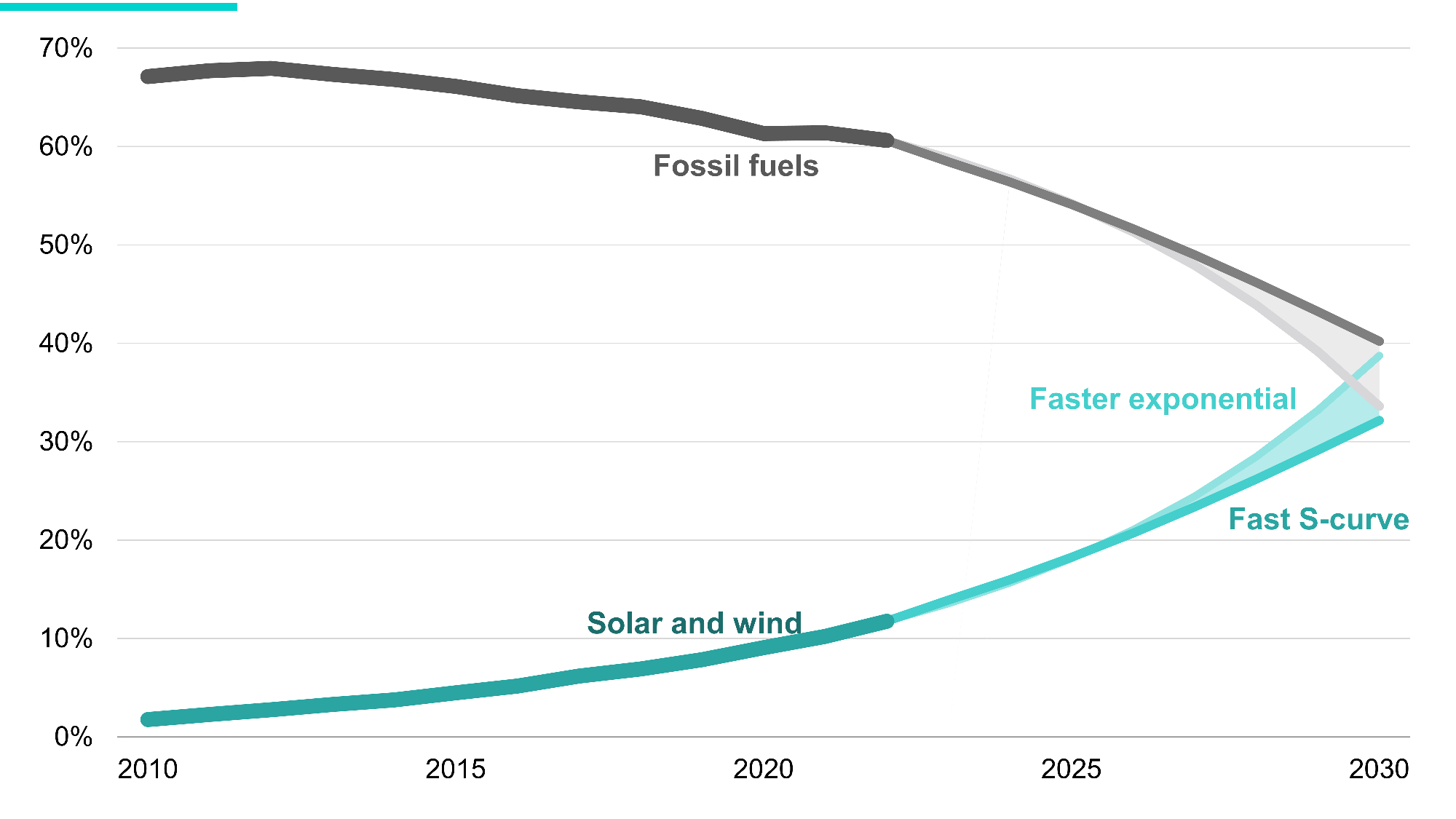
RMI, formerly known as the Rocky Mountain Institute, in collaboration with Bezos Earth Fund, has issued a new report that claims fully one-third of all the electricity the world needs will come from renewable sources in 2030. Today, about 12% comes from renewables.
Solar, wind, and batteries have been following a typical path for new technology, the RMI report says. Learning curves lead to falling prices, which in turn lead to rapid growth in new capacity. New solar and battery capacity, policy targets, the momentum of change, and the logic of S curves all point to continued exponential growth in solar and wind generation for the rest of this decade at 15%–20% a year.
The RMI report claims that superior economics, energy security, climate necessity, and local pollution remain a powerful combination for change in the global electricity sector. Furthermore, its analysis shows that the cost of solar power, the cheapest energy source in history, will fall by 50% by the end of this decade.
RMI & Exponential Growth
Despite those who say insurmountable barriers to the energy transition are everywhere, growth keeps happening. While barriers are specific and local, solutions are generic and global and will continue to overwhelm resistance to change. As a result, fast growth will lead to a tripling in solar and wind generation by 2030, while faster growth will mean a quadrupling in generation, to produce more than 14,000 terawatt-hours (TWh) and overtake fossil fuel supply.
“But this is a call to action, not a moment to sit back, ” RMI says. “Around the world, countries, in partnership with the private sector, need to build out grids, change permitting laws, scale up flexibility solutions, improve regulatory and market systems, and speed up deployment in the Global South.”
This exponential growth in renewable electricity is unlocking widespread benefits, including security of supply and jobs growth, as well as countering energy price inflation. Based on the forecasts, solar and wind could generate up to 14,000 TWh of electricity by 2030. That is 3 to 4 times higher than 2022 levels. It would also more the triple the renewable energy capacity being called for by the organizers of the COP28 climate conference scheduled for this fall.
Meanwhile, fossil fuel demand for electricity will be in steep decline, the RMI analysis says. It foresees a decrease of up to 30% from the 2022 peak by 2030 as renewable electricity further out-competes hydrocarbons on cost.
China & Europe Lead
The RMI study finds that China and Europe are leading the way in rapidly adopting clean energy technology. However, the deployment of renewable energy is becoming more evenly distributed globally, including across the Middle East and Africa, which are rapidly catching up with and harnessing the global growth trend. It is important to keep in mind that many parts of Africa are not served by a traditional electrical grid, which means they can transition directly to solar power and local microgrids without the expense of planning and constructing traditional grids.
Uruguay, Denmark, Lithuania, Namibia, Netherlands, Palestine, Jordan, and Chile have all already grown solar and wind generation at rapid speeds, demonstrating that a rapid transition can be achieved across many different contexts, according to research from Systems Change Lab.
Globally, wind and solar need to grow from 12% to 41% by 2030, an increase of 29%. Denmark, Uruguay, and Lithuania have already achieved such an increase over a comparable span of eight years. Namibia, the Netherlands, Palestine, Jordan, and Chile have grown solar and wind generation at sufficient rates for five years.
These countries scaled up wind and solar under very different circumstances. Some have an average GDP per capita of $4000, while in others the GDP per capita is as much as $67,000 per year. Despite their economic differences, all of them were driven to accelerate the adoption of renewables by a variety of factors, such as adopting smart and effective policies, maintaining political commitment, lowering the costs of renewable power, and improving energy security.
“The exponential growth trend in renewable electricity can be harnessed to help developing countries get ahead of the curve and transition faster to a cleaner and more affordable electricity system,” Andrew Steer, CEO of the Bezos Earth Fund.
The Cost Advantage Of Green Energy
Exponential rates of deployment are driving down renewable prices at unprecedented pace, rendering higher cost hydrocarbons uncompetitive in most markets, RMI says. It forecasts that the cost of solar power could be cut in half — from $40/MWh to $20/MWh — between now and 2030. Solar and battery costs have declined 80% since 2012, while offshore wind costs have declined 73% and onshore wind costs are down by 57%, according to data from BNEF.
“Exponential growth of clean energy is an unstoppable force that will put more spending power in the pockets of consumers. The benefit of rapid renewable deployment is greater energy security and independence, plus long-term energy price deflation because this is a manufactured technology — the more you install the cheaper it gets,” said Kingsmill Bond, the head of RMI.
Every two years, the nations of the world report the results of their efforts to meet the goals of the Paris Agreements of 2015. RMI expects this year’s reports will show a significant shortfall when those reports are submitted. But it says to not despair. Exponential growth of new energy technologies will continue to displace thermal generation from fossil fuels and nuclear. Electricity and road transport account for more than half of fossil fuel demand. Both have reached tipping points in demand that will pave the way for widespread adoption of renewables.

Linear Vs. Exponential
To illustrate the difference between the linear and exponential, consider the question of solar capacity in 2050. Assume that it is necessary to deploy 30,000 gigawatts (GW) of solar panels by 2050 in order to get to net zero. In 2022, 250 GW of solar panels were installed, according to BNEF, and total deployment at the end of the year was 1,200 GW of solar.
The orthodox approach would argue that it is necessary to deploy 1,000 GW a year. If in fact only 250 GW are deployed, the goal will never be reached. But that analysis does not take into account the power of exponential growth, as represented by the S Curve.
To get to 30,000 GW in 2050, RMI says we need to keep on going up the S curve to around 1,000 GW in 2030, and rise to a little above that level for the next 20 years. That will get the world to 30,000 GW of solar capacity by 2050. It is completely feasible, so long as the nations of the world stay on track.
“This is a clear signal to policy makers, businesses and investors to seize the opportunity of accelerating the energy transition. The call to triple renewable electricity investment and capacity by 2030 are deliverable. But only by removing barriers to faster renewable deployment, from streamlining permitting to redirecting subsidies for polluting energy. Otherwise, the exponential growth we are seeing and the benefits that come with it could be derailed unnecessarily,” said Christiana Figueres, formerly the executive secretary of UNFCCC and a founding partner of Global Optimism.
If there is a takeaway from the RMI study, it is this. The cost of renewables will continue to fall. Other sources of electricity won’t be able to compete. Adam Smith’s unseen hand will work its magic. Case closed.
I don’t like paywalls. You don’t like paywalls. Who likes paywalls? Here at CleanTechnica, we implemented a limited paywall for a while, but it always felt wrong — and it was always tough to decide what we should put behind there. In theory, your most exclusive and best content goes behind a paywall. But then fewer people read it! We just don’t like paywalls, and so we’ve decided to ditch ours. Unfortunately, the media business is still a tough, cut-throat business with tiny margins. It’s a never-ending Olympic challenge to stay above water or even perhaps — gasp — grow. So …
Sign up for daily news updates from CleanTechnica on email. Or follow us on Google News!
Have a tip for CleanTechnica, want to advertise, or want to suggest a guest for our CleanTech Talk podcast? Contact us here.
Former Tesla Battery Expert Leading Lyten Into New Lithium-Sulfur Battery Era:
CleanTechnica uses affiliate links. See our policy here.





